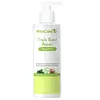What's inside
What's inside
 Key Ingredients
Key Ingredients

 Benefits
Benefits

 Concerns
Concerns

 Ingredients Side-by-side
Ingredients Side-by-side

Water
Skin ConditioningSodium Lauroyl Sarcosinate
CleansingCocamidopropyl Betaine
CleansingSodium Cocoyl Isethionate
CleansingDecyl Glucoside
CleansingGluconamido Amodimethicone
PEG-8 Amodimethicone
Glycol Stearate
EmollientPEG-150 Distearate
EmulsifyingGlycerin
HumectantDimethiconol
EmollientTea-Dodecylbenzenesulfonate
CleansingPhenoxyethanol
PreservativeSodium PCA
HumectantSodium Benzoate
MaskingPolyquaternium-10
Guar Hydroxypropyltrimonium Chloride
Skin ConditioningSodium Gluconate
Skin ConditioningArginine
MaskingHydrolyzed Keratin
HumectantHydrolyzed Collagen
EmollientHydrolyzed Wheat Protein
Skin ConditioningPanthenol
Skin ConditioningLactic Acid
BufferingCeramide AP
Skin ConditioningOligopeptide-2
Skin ConditioningBrassica Oleracea Acephala Leaf Extract
HumectantWater, Sodium Lauroyl Sarcosinate, Cocamidopropyl Betaine, Sodium Cocoyl Isethionate, Decyl Glucoside, Gluconamido Amodimethicone, PEG-8 Amodimethicone, Glycol Stearate, PEG-150 Distearate, Glycerin, Dimethiconol, Tea-Dodecylbenzenesulfonate, Phenoxyethanol, Sodium PCA, Sodium Benzoate, Polyquaternium-10, Guar Hydroxypropyltrimonium Chloride, Sodium Gluconate, Arginine, Hydrolyzed Keratin, Hydrolyzed Collagen, Hydrolyzed Wheat Protein, Panthenol, Lactic Acid, Ceramide AP, Oligopeptide-2, Brassica Oleracea Acephala Leaf Extract
Water
Skin ConditioningCetearyl Alcohol
EmollientDimethicone
EmollientPEG-7 Propylheptyl Ether
Emulsion StabilisingCetrimonium Chloride
AntimicrobialStearamidopropyl Dimethylamine
EmulsifyingBehentrimonium Chloride
PreservativeDipropylene Glycol
HumectantHydroxypropylgluconamide
HumectantHydroxypropylammonium Gluconate
HumectantAcrylamidopropyltrimonium Chloride/Acrylamide Copolymer
Cocos Nucifera Oil
MaskingParfum
MaskingPisum Sativum Peptide
Skin ConditioningHydrolyzed Wheat Protein
Skin ConditioningLysine Hcl
Skin ConditioningOlea Europaea Fruit Oil
MaskingLactic Acid
BufferingDisodium EDTA
Sodium Chloride
MaskingCeramide AP
Skin Conditioning1,2-Hexanediol
Skin ConditioningBenzyl Alcohol
PerfumingBenzyl Salicylate
PerfumingCitronellol
PerfumingLimonene
PerfumingLinalool
PerfumingWater, Cetearyl Alcohol, Dimethicone, PEG-7 Propylheptyl Ether, Cetrimonium Chloride, Stearamidopropyl Dimethylamine, Behentrimonium Chloride, Dipropylene Glycol, Hydroxypropylgluconamide, Hydroxypropylammonium Gluconate, Acrylamidopropyltrimonium Chloride/Acrylamide Copolymer, Cocos Nucifera Oil, Parfum, Pisum Sativum Peptide, Hydrolyzed Wheat Protein, Lysine Hcl, Olea Europaea Fruit Oil, Lactic Acid, Disodium EDTA, Sodium Chloride, Ceramide AP, 1,2-Hexanediol, Benzyl Alcohol, Benzyl Salicylate, Citronellol, Limonene, Linalool
Ingredients Explained
These ingredients are found in both products.
Ingredients higher up in an ingredient list are typically present in a larger amount.
Ceramide AP is formally known as Ceramide 6.
Ceramides are intercellular lipids naturally found in our skin that bonds dead skin cells together to create a barrier. Having a strong skin barrier leads to more firm and hydrated skin.
They are known for their ability to hold water and thus are a great ingredient for dry skin. By bolstering the skin ceramides act as a barrier against irritating ingredients. This can help with inflammation as well.
If you would like to eat ceramides, sweet potatoes contain a small amount.
Read more about other common types of ceramides here:
Ceramide NP
Ceramide EOP
We don't have a description for Hydrolyzed Wheat Protein yet.
Lactic Acid is another well-loved alpha hydroxy acid (AHA). It is gentler than glycolic acid but still highly effective.
Its main role is to exfoliate the surface of the skin by loosening the “glue” that holds dead skin cells together. Shedding those old cells leads to smoother, softer, and more even-toned skin.
Because lactic acid molecules are larger than glycolic acid, they don’t penetrate as deeply. This means they’re less likely to sting or irritate, making it a great choice for beginners or those with sensitive skin.
Like glycolic acid, it can:
Lactic acid also acts as a humectant (like hyaluronic acid). It can draw water into the skin to improve hydration and also plays a role in the skin's natural moisturizing factor (NMF) in the form of sodium lactate.
Studies show it can boost ceramide production to strengthen the skin barrier and even help balance the skin’s microbiome.
To get results, choose products with a pH between 3-4.
Lower strengths (5-12%) focus on surface exfoliation; higher strengths (12% and up) can reach deeper in the dermis (deeper, supportive layer) to improve skin texture and firmness over time.
Though it was originally derived from milk, most modern lactic acid used in skincare is vegan. It is made through non-dairy fermentation to create a bio-identical and stable form suitable for all formulations.
When lactic acid shows up near the end of an ingredient list, it usually means the brand added just a tiny amount to adjust the product’s pH.
Legend has it that Cleopatra used to bathe in sour milk to help reduce wrinkles.
Lactic acid is truly a gentle multitasker: it exfoliates, hydrates, strengthens, and brightens. It's a great ingredient for giving your skin a smooth, glowing, and healthy look without the harshness of stronger acids.
Read more about some other popular AHA's here:
Learn more about Lactic AcidWater. It's the most common cosmetic ingredient of all. You'll usually see it at the top of ingredient lists, meaning that it makes up the largest part of the product.
So why is it so popular? Water most often acts as a solvent - this means that it helps dissolve other ingredients into the formulation.
You'll also recognize water as that liquid we all need to stay alive. If you see this, drink a glass of water. Stay hydrated!
Learn more about Water